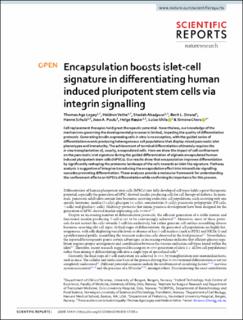| dc.contributor.author | Legøy, Thomas Aga | |
| dc.contributor.author | Vethe, Heidrun | |
| dc.contributor.author | Abadpour, Shadab | |
| dc.contributor.author | Strand, Berit Løkensgard | |
| dc.contributor.author | Scholz, Hanne | |
| dc.contributor.author | Paulo, Joao A. | |
| dc.contributor.author | Ræder, Helge | |
| dc.contributor.author | Ghila, Luiza | |
| dc.contributor.author | Chera, Simona | |
| dc.date.accessioned | 2021-04-28T11:51:15Z | |
| dc.date.available | 2021-04-28T11:51:15Z | |
| dc.date.created | 2020-09-28T16:17:32Z | |
| dc.date.issued | 2020 | |
| dc.identifier.issn | 2045-2322 | |
| dc.identifier.uri | https://hdl.handle.net/11250/2740158 | |
| dc.description.abstract | Cell replacement therapies hold great therapeutic potential. Nevertheless, our knowledge of the mechanisms governing the developmental processes is limited, impeding the quality of differentiation protocols. Generating insulin-expressing cells in vitro is no exception, with the guided series of differentiation events producing heterogeneous cell populations that display mixed pancreatic islet phenotypes and immaturity. The achievement of terminal differentiation ultimately requires the in vivo transplantation of, usually, encapsulated cells. Here we show the impact of cell confinement on the pancreatic islet signature during the guided differentiation of alginate encapsulated human induced pluripotent stem cells (hiPSCs). Our results show that encapsulation improves differentiation by significantly reshaping the proteome landscape of the cells towards an islet-like signature. Pathway analysis is suggestive of integrins transducing the encapsulation effect into intracellular signalling cascades promoting differentiation. These analyses provide a molecular framework for understanding the confinement effects on hiPSCs differentiation while confirming its importance for this process. | en_US |
| dc.language.iso | eng | en_US |
| dc.publisher | Nature | en_US |
| dc.rights | Navngivelse 4.0 Internasjonal | * |
| dc.rights.uri | http://creativecommons.org/licenses/by/4.0/deed.no | * |
| dc.title | Encapsulation boosts islet-cell signature in differentiating human induced pluripotent stem cells via integrin signalling | en_US |
| dc.type | Journal article | en_US |
| dc.type | Peer reviewed | en_US |
| dc.description.version | publishedVersion | en_US |
| dc.rights.holder | Copyright 2020 The Authors | en_US |
| dc.source.articlenumber | 414 | en_US |
| cristin.ispublished | true | |
| cristin.fulltext | original | |
| cristin.qualitycode | 1 | |
| dc.identifier.doi | 10.1038/s41598-019-57305-x | |
| dc.identifier.cristin | 1834455 | |
| dc.source.journal | Scientific Reports | en_US |
| dc.source.40 | 15 | |
| dc.source.14 | 10 | |
| dc.identifier.citation | Scientific Reports. 2020, 10:414 | en_US |
| dc.source.volume | 10 | en_US |

